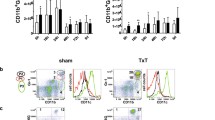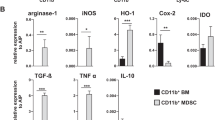Abstract
Introduction
Prolonged immunosuppression has been demonstrated after trauma-hemorrhage resulting in an increased susceptibility to sepsis. The contribution of antigen-presenting cells (APC) vs T cells to this diminished immune response, however, remains unknown.
Materials and methods
To study this, male mice were trauma-hemorrhaged (35 ± 5 mmHg for 90 min and resuscitation) or sham operated. At 24 h thereafter, spleens were harvested and T cells (via Microbeads) and APC (via adherence) were isolated. Cocultures of combined T cells and APC were established for 48 h, stimulated with ConA and LPS. The T cell-derived cytokine IFN-γ and IL-12 for APC responses were measured in the supernatants by the multiplex assay.
Results
The release of IFN-γ was suppressed by T cells after trauma-hemorrhage irrespective of whether sham or trauma-hemorrhage APC were added. Trauma-hemorrhaged APC did not affect T cells-derived IFN-γ release by sham T cells. In contrast, trauma-hemorrhaged T cells depressed the release of IL-12 by APC. The release of IL-12 by trauma-hemorrhaged APC was not altered when sham T cells were cocultured.
Conclusion
Prolonged immunosuppression after trauma-hemorrhage appears to be predominantly due to diminished T cell function. Thus, attempts to prevent immunodysfunction should be directed towards T cells.



Similar content being viewed by others
References
Angele MK, Chaudry IH (2005) Surgical trauma and immunosuppression: pathophysiology and potential immunomodulatory approaches. Langenbeck’s Arch Surg 390(4):333–341
Lenschow DJ, Walunas TL, Bluestone JA (1996) CD28/B7 system of T cell costimulation. Annu Rev Immunol 14:233–258
Angele MK, Knöferl MW, Schwacha MG, Ayala A, Cioffi WG, Bland KI, Chaudry IH (1999) Sex steroids regulate pro- and anti-inflammatory cytokine release by macrophages after trauma-hemorrhage. Am J Physiol 277:C35–C42
Robson NC, Beacock-Sharp H, Donachie AM, Mowat AM (2003) The role of antigen-presenting cells and interleukin-12 in the priming of antigen-specific CD4+ T cells by immune stimulating complexes. Immunology 110(1):95–104
Heufler C, Koch F, Stanzl U, Topar G, Wysocka M, Trinchieeri G, Enk A, Steinman RM, Romani N, Schuler G (1996) Interleukin-12 is produced by dendritic cells and mediates T helper 1 development as well as interferon-gamma production by T helper 1 cells. Eur J Immunol 26(3):659–668
Angele MK, Knoferl MW, Ayala A, Bland KI, Chaudry IH (2001) Testosterone and estrogen differently effect Th1 and Th2 cytokine release following trauma-haemorrhage. Cytokine 16(1):22–30
Ayala A, Wang P, Chaudry IH (1993) Insights into the mechanism by which interferon-gamma improves macrophage function following hemorrhage and resuscitation. J Surg Res 54(4):322–327
Celada A, Gray PW, Rinderknecht E, Schreiber RD (1984) Evidence for a gamma-interferon receptor that regulates macrophage tumoricidal activity. J Exp Med 160(1):55–74
Nambu M, Morita M, Watanabe H, Uenoyama Y, Kim KM, Iwai Y, Kimata H, Mayumi M, Mikawa H (1989) Regulation of Fc gamma receptor expression and phagocytosis of a human monoblast cell line U937. Participation of cAMP and protein kinase C in the effects of IFN-gamma and phorbol ester. J Immunol 143(12)4158–4165
Xu YX, Ayala A, Chaudry IH (1998) Prolonged immunodepression after trauma and hemorrhagic shock. J Trauma 44(2):335–341
Kawasaki T, Hubbard WJ, Choudry MA, Schwacha MG, Bland KI, Chaudry IH (2006) Depressed splenic dendritic cell antigen presentation function following trauma-hemorrhage. Shock 25[Suppl]:50
Ni Choileain N, Redmond HP (2006) Cell response to surgery. Arch Surg 141(11):1132–1140
Angele MK, Schwacha MG, Ayala A, Chaudry IH (2000) Effect of gender and sex hormones on immune responses following shock. Shock 14(2):81–90
Zellweger R, Ayala A, DeMaso CM, Chaudry IH (1995) Trauma-hemorrhage causes prolonged depression in cellular immunity. Shock 4(2):149–153
Angele MK, Faist E (2002) Clinical review: immunodepression in the surgical patient and increased susceptibility to infection. Crit Care 6(4):298–305
Ni Choileain N, Redmond HP (2006) The immunological consequences of injury. Surgeon 4(1):23–31
Keel M, Trentz O (2005) Pathophysiology of polytrauma. Injury 36(6):691–709
Angele MK, Ayala A, Cioffi WG, Bland KI, Chaudry IH (1998) Testosterone: the culprit for producing splenocyte immune depression after trauma hemorrhage. Am J Physiol 274(6 Pt 1):C1530–C1536
Montoya MC, Sancho D, Vicente-Manzanares M, Sanchez-Madrid F (2002) Cell adhesion and polarity during immune interactions. Immunol Rev 186:68–82
Delon J, Stoll S, Germain RN (2002) Imaging of T-cell interactions with antigen presenting cells in culture and in intact lymphoid tissue. Immunol Rev 189:51–63
Ayala A, Chung Cs, Xy YX, Evans TA, Redmond KM, Chaurdy IH (1999) Increased inducible apoptosis in CD4+ T lymphocytes during polymicrobial sepsis is mediated by Fas ligand and not endotoxin. Immunology 97(1):45–55
Shelley O, Murphy T, Paterson H, Mannick JA, Lederer JA (2003) Interaction between the innate and adaptive immune systems is required to survive sepsis and control inflammation after injury. Shock 20(2):123–129
Berger SL (1975) Lymphocytes as resting cells. Methods Enzymol 58:486–494
Landy M, Baker PJ (1966) Cytodynamics of the distinctive immune response produced in regional lymph nodes by Salmonella somatic polysaccharide. J Immunol 97(5):670–679
Smith KA (1988) Interleukin-2: inception, impact, and implications. Science 240(4856):1169–1176
Ransom J, Fischer M, Mosmann T, Yokota T, DeLuca D, Schumacher J, Zlotnik A (1987) Interferon-gamma is produced by activated immature mouse thymocytes and inhibits the interleukin 4-induced proliferation of immature thymocytes. J Immunol 139(12):4102–4108
Wysocka M, Robertson S, Riemann H, Caamano J, Hunter C, Mackiewicz A, Montaner LJ, Trinchieri G, Karp CL (2001) IL-12 suppression during experimental endotoxin tolerance: dendritic cell loss and macrophage hyporesponsiveness. J Immunol 166(12):7504–7513
Asthana D, Yang WC, Fuller L, Zucker K, Lu P, Zheng S, Esquenazi V, Carreno M, Roth D, Burke GW (1993) Differential effects of IFN-gamma on kidney cell expression of MHC class II molecules, kidney cell associated molecules and their stimulatory capacity in mixed lymphocyte kidney cell culture. Transpl Immunol 1(4):282–293
Ertel W, Keel M, Neidhardt R, Steckholzer U, Kremer JP, Ungethuem U, Trentz O (1997) Inhibition of the defense system stimulating interleukin-12 interferon-gamma pathway during critical illness. Blood 89(5):1612–1620
Ayala A, Ertel W, Chaudry IH (1996) Trauma-induced suppression of antigen presentation and expression of major histocompatibility class II antigen complex in leukocytes. Shock 5(2):79–90
Kawasaki T, Hubbard WJ, Choudry MA, Schwacha MG, Bland KI, Chaudry IH (2006) Trauma-hemorrhage induces depressed splenic dendritic cell functions in mice. J Immunol 177(7):4514–4520
Granucci F, Zanoni I, Feau S, Ricciardi-Castagnoli P (2003) Dendritic cell regulation of immune responses: a new role for interleukin 2 at the intersection of innate and adaptive immunity. EMBO J 22(11):2546–2551
Acknowledgment
This investigation was supported by a grant from the Deutsche Forschungsgesellschaft DFG AN 357/1-1.
Author information
Authors and Affiliations
Corresponding author
Rights and permissions
About this article
Cite this article
Walz, C.R., Zedler, S., Schneider, C.P. et al. Depressed T cell-derived IFN-γ following trauma-hemorrhage: a potential mechanism for diminished APC responses. Langenbecks Arch Surg 392, 339–343 (2007). https://doi.org/10.1007/s00423-007-0164-7
Received:
Accepted:
Published:
Issue Date:
DOI: https://doi.org/10.1007/s00423-007-0164-7




